All about the use of ferrous sulfate in gardening

The use of ferrous sulfate in horticulture is a completely justified step to increase plant protection without the accumulation of harmful substances in their tissues. It is not at all difficult to figure out how to breed it - instructions and proportions are on the packaging, in addition, you can find additional materials, tables. Usually, the garden is treated in the fall and the trees are sprayed in the spring, but there are other times when it is impossible to do without the use of ferrous sulfate.
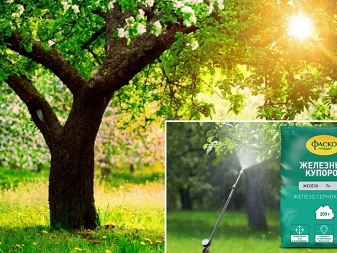

Peculiarities
Ferrous sulfate, a chemical compound known as ferrous sulfate, has the formula FeSO4. This substance belongs to fungicides - substances used to fight fungal diseases of plants. Iron vitriol has a contact effect, without a cumulative effect. It does not accumulate in plant parts, which makes it possible to exclude negative manifestations during the growing season.
Iron is a trace element necessary for plants for the proper passage of cell metabolism. It is it that influences the formation of chlorophyll, ensures the sufficient production of this substance. Iron vitriol has the appearance of a crystalline substance with a greenish tint. Its structure is not transparent, there is no specific smell. Crystals are breathable, easily dissolve in warm water; in industrial production for household purposes, the proportion of the main substance in the composition of the drug should be from 54% or more.
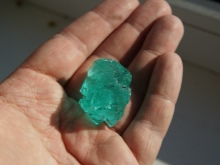
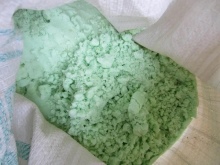
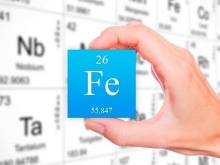
The use of ferrous sulfate in gardening is quite diverse. Among the most common reasons for using it are the following.
- Improving soil composition. Iron sulfate is effective when added to soils with a high content of carbonates, phosphorus, magnesium or salt.
- Prevention of fungal infection. In this case, a weakly concentrated solution is used with an iron sulfate content of 1-3%.
- Treatment of fungal diseases. Repeated spraying is required. 1 treatment is enough for about 14 days.
- Fight against mosses and lichens on tree trunks. Also, fungicidal treatment helps to cope with them on any wooden buildings.
- Chlorosis of plants. Preventive treatment or treatment can be carried out here. Watering at the root, spraying of plants is carried out. Iron vitriol is effective only for non-infectious chlorosis.
- Insect pest control. Here the solution is used at 5% concentration.
- Treatment of hollows, treatment of wounds on the trunks. The disinfectant and astringent properties of the product are very high.
Iron sulfate is well suited for seasonal use. They can process trees and shrubs at temperatures not lower than 0 degrees Celsius. Not all fungicides have this advantage.
In addition, it is suitable for the disinfection of cesspools much better than bleach, it is safe for the environment.
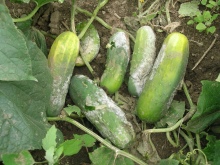
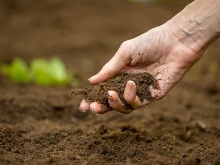
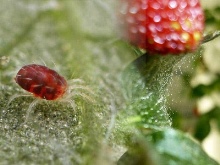
How to breed correctly?
A special table will help to maintain the correct proportions when mixing ferrous sulfate with water for different crops. There are other important points as well. For example, if the proportions are violated and the concentration exceeds the recommended values, the treatment can be dangerous for the plants. Experienced gardeners believe that it is better to dilute and dissolve the substance in smaller dosages than ruin the planting.
Before preparing the solution with your own hands, you should study the following recommendations.
- Stone fruits are cultivated only on vines or bare branches. Usually the concentration does not exceed 3%, that is, 300 g of powder is required to be diluted per 10 liters of water. Spraying is carried out in the autumn.
- Pome crops are processed in spring. For an area of 100 m2, about 10 liters of a solution at a concentration of 4-5% are required.
- Fighting mold, mosses, lichens. Here, the most concentrated solution is used with an iron sulfate content of 5-6%.
- In the absence of scales, you can navigate the preparation of the solution by other measures. For example, to prepare a 2% solution, you need 5 tablespoons of dry powder per 10 liters of water. The solution will turn out to be bright orange. It is worth considering that all the cited standards are indicated for dry powder containing 53% ferrous sulfate.
- It is better to prepare the preparation in warm water. This will dissolve the crystals much better. It is better to take melted or rain water, the softest. You cannot prepare the solution in a metal container; it is better to take a plastic container. You need to add the powder gradually, in small doses, stirring with a wooden spatula, you can prepare a concentrate of 1-2 liters, and then dilute it to the required volume.
Processing should be carried out in the spring and autumn for a reason. Iron vitriol is detrimental to the green leaf and causes burns to its tissues. Doses of a solution with a concentration of 3-5% have a very acidic reaction.
In addition, spring treatment slows down the growing season of plants by about 7 days. This can be used to protect delicate buds from possible frost damage.
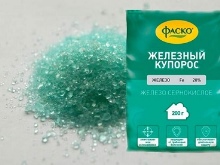
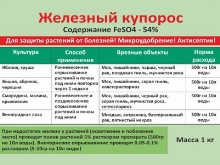
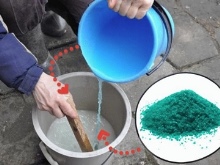
Instructions for use
Features of the use of ferrous sulfate are largely associated with the properties of this drug. In spring and autumn, it is used in different ways; the solution can be diluted in a low concentration or made stronger. For raspberries and other shrubs, you need to choose one dosage, for deciduous trees and for conifers, a different dosage. Rehabilitation from diseases and pests is also carried out according to strictly defined rules - so as not to harm the plants.
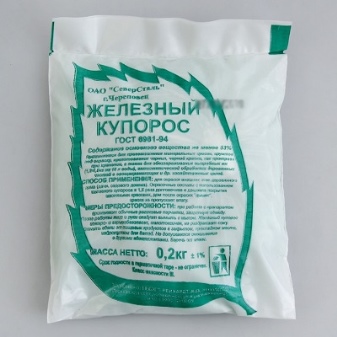

Processing the vine
Perhaps this is the most popular field of application of iron sulfate. For a vine vulnerable to many diseases, such protection is imperative. In the spring, spraying is carried out with a solution in a weak concentration, in the fall, sanitation is repeated, shortly before the onset of frost. Foliar processing is also possible.
In the spring, immediately after removing the cover from the vine, spraying should be performed. A slightly concentrated composition with a content of no more than 1% ferrous sulfate is suitable. More reliable protection is required before wintering. The optimal concentration of the solution will be 3-5%, it is also used in pest control, as well as in odium, spotting.
With chlorosis, a 0.05% mixture of water and ferrous sulfate is used. Root feeding is also possible. To do this, dissolve 10-15 g (half a tablespoon) of the substance in 10 liters of liquid in water.
Such an additive is useful for grapes showing weak vine growth, blanching of leaves, slow ripening of bunches. Top dressing can be combined with planned watering.

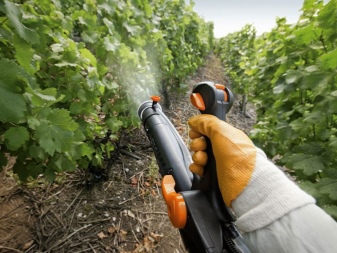
Tree processing
For fruit trees, treatment with iron sulfate can be used as a measure of protection against insect pests, lichens. Affected wood and bark will be cleared of growths by the summer. In addition, when used correctly, an overall improvement in plant health can be achieved. They look healthy, bear fruit more abundantly, and improve the quality of the fruit.
It is possible to process hardwoods in the spring at a concentration of 5-7% (500-700 g of powder per 10 liters) even before the buds appear. The optimal time for this is morning or evening hours. Spraying is carried out in the fall. It is important to know: it is absolutely impossible to add lime to the solution - it is needed to combine with copper sulfate. Root watering is carried out in the spring. A 1% solution is used here, watering is carried out at a rate of about 3 liters per 1 m2.
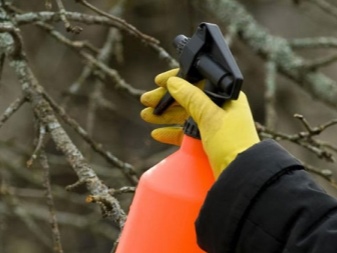

We will also give some recommendations for spraying for different fruit crops.
- Apple trees and pears. Spraying is carried out with a 3% solution, twice, with a break of 2 weeks. Irrigation should not be carried out after the appearance of the green mass.
- Quince. Iron vitriol in 1% concentration helps to rid fruit trees of such dangerous diseases as moniliosis, scab. For 1 plant, about 2-5 liters of solution are consumed; after flowering, reorganization is no longer carried out.
- Peach, apricot. They need to be sprayed with a 1% solution in a volume of 2-3 liters per 1 tree. Processing is carried out only in early spring.
- Plum, sweet cherry, cherry. The first treatment is needed before the leaves appear, the second - after flowering. For 1 tree, 2-3 liters of funds are required.
Iron vitriol is suitable for processing conifers. For them, fungicidal treatment is practically the only way to effectively protect against mold, rot, and other types of lesions. Spraying the bark on the trunk and branches is done in the fall. It is also possible to treat hollows and wounds as a measure of disinfection, treatment.

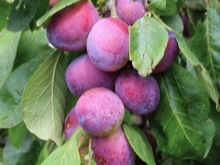
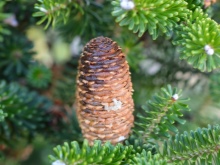
Spraying flowering shrubs
Fruiting and flowering shrubs can be sprayed only once, in the spring. Ferrous sulfate helps provide protection and treatment against anthracnose, various types of spotting. For currants, raspberries, gooseberries, it is important not to miss the moment before the leaves appear. For the shrub, 1-2 liters of solution with a concentration of 1% are consumed.

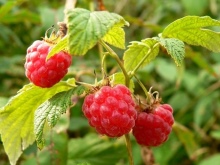
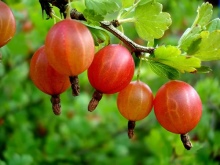
Garden processing in autumn
In the garden, ferrous sulfate can be used quite widely. For example, bush and climbing roses are shown spring spraying with a solution concentration of 1-3%. Possible antifungal treatment after flowering. In this case, the mixture is prepared from 50 g of ferrous sulfate per 10 liters of water. Autumn treatment helps protect plants before wintering. Strawberries also need protection from diseases and pests. In the fight against fungi that provoke the development of powdery mildew, gray rot, late blight, spotting, a 0.3% solution of ferrous sulfate is used. It is added to organic dressing, applied at the root in the fall, after harvest.
To reduce the risk of re-development of diseases, you need to carefully remove the fallen leaves before wintering. Autumn is the best time to treat tree cuts and wounds. Cracks on the surface of the bark found after dropping the leaves are disinfected with 1% iron sulfate using a brush. To disinfect deep wounds and hollows, a higher concentration of the substance is required. Here you need 10% ferrous sulfate.
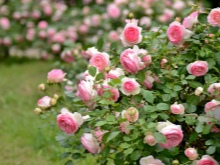
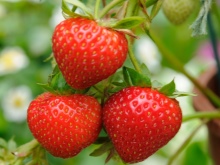
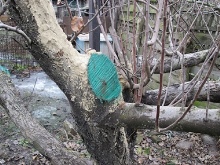
Additional treatment with urea
When fighting diseases, pests in the garden, a mono-component solution is most often used in the garden. But the treatment with iron vitriol and urea works much more efficiently. This combination of substances can significantly reduce the amount of required agrotechnical measures. Urea fertilizer provides the soil with nitrogen, which is necessary for the successful growth and development of plants. Iron vitriol prevents chlorosis, fungal infections.
In addition to the two main components, in the combined processing, the third is most often used - citric acid, and to obtain the optimal consistency, you can add 200 ml of liquid soap on a natural basis to the mixture. This composition is especially effective when used in autumn. With its help, the release of foliage is accelerated, the bark ripens faster on young shoots. Litter on the ground can also be sprayed to destroy pathogenic microorganisms or pests, it will rot faster, and will not create problems during spring cleaning.

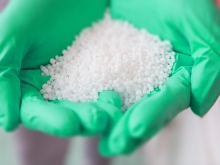
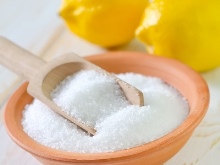
The recipe for the combined product is quite simple.
- Warm up 1.5-2 liters of water. This will allow for better dissolution of chemicals.
- Dissolve 350-500 g of ferrous sulfate in water. It is necessary to achieve complete dissolution of the crystals.
- Add 10 g of citric acid to the mixture. It will prevent the oxidation of ferrous sulfate and extend its life.
- Separately dilute urea in 7-8 liters of water in a volume of 500-800 g. To achieve dissolution of the substance.
- Combine the components, receiving about 10 liters of the finished composition. If necessary, you can add water.
Processing is best done in the fall. In this case, by spring, the garden will be fully ready for the growing season of plants, it will not require additional nitrogen fertilization.
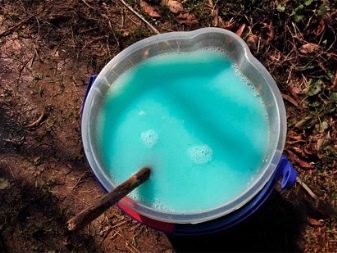
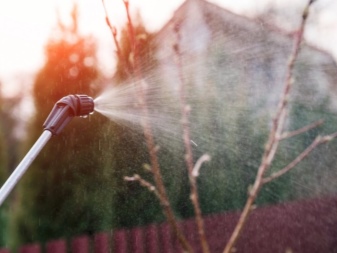
Precautionary measures
Iron vitriol is a chemical substance belonging to the III hazard class. It is not too harmful to human health, but it does not mean that the risks can be neglected. As with other types of work in the garden, it is worth taking care of the individual protection of the skin of the hands, respiratory organs and mucous membranes. For this, work gloves are used - preferably nitrile or rubber, the face is covered with a respirator.
When spraying the garden, clothes should be covered, you can put on a raincoat, rubber boots on your feet. In order to prevent the mixture from damaging the eyes, it is recommended to use special glasses. During the period of direct application of the solution, pets and children should be isolated. Do not mix the composition with other drugs (except urea) at the same time, since the plant may suffer as a result of a chemical reaction.

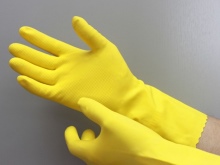
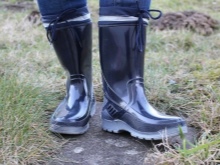













The comment was sent successfully.